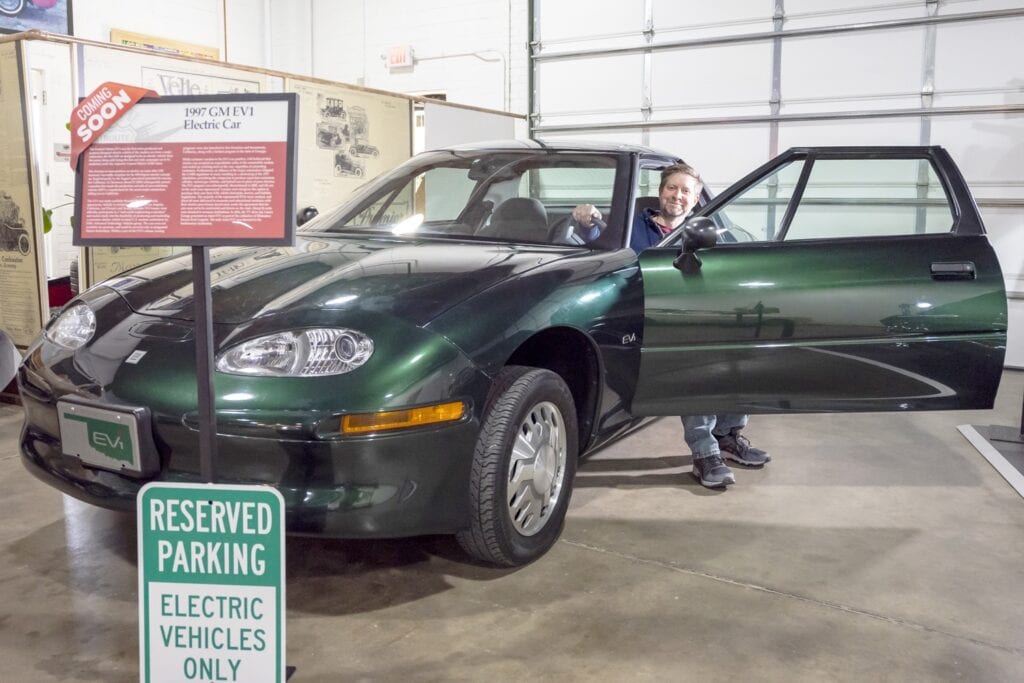The Heart of Route 66 Auto Museum introduced a decidedly different kind of car into its collection of classic automobiles on Friday morning.
The General Motors EV1, the very first mass-produced electric vehicle designed from the ground up by a major manufacturer, is now on display at the museum. Produced from just 1996 to 1999, the GM EV1 was only available for lease, not purchase.
Doug Duke, President of the Oklahoma Electric Auto Association, spoke to Sapulpa Times about the vehicle, and how rare it is to have one in Oklahoma.
“It’s the only one that I know of, in between Los Angeles, and Atlanta,” Duke said. “They made 1,500 or 2,000 of these, but they recalled them and destroyed most of them, so there’s only about 15 or 20 of them left in the entire world.”
The majority of the EV1s available to be seen today are deactivated and not able to be driven. The one on loan at the Rt. 66 Auto Museum is one such vehicle. There’s one place where you can see one that’s still drivable. “It’s in the Smithsonian,” Duke says.

The EV1 is certainly not the first electric vehicle that had ever been produced, but it is largely believed to be the first that had mass appeal. The EV1 is based on the GM Impact, a testing prototype for electric car development by GM that came out in the early 1990s and was described by Motor Trend magazine as “the world’s only electric vehicle that drives like a real car.” Whereas most electric vehicles produced up to that point could hardly reach 40 mph, the GM Impact reached a top speed of 183 mph and car reviewers were pleased. They saw the Impact as the first viable replacement for a combustion engine that could be built into a family car.
Interestingly, GM was not exactly happy that they had achieved such a milestone. In a story in the New York Times, GM said that the vehicles—largely driven to production by California mandates to create more zero-emissions vehicles—“were not yet viable” and they still weren’t sure if consumers even wanted electric cars.
Still, GM pushed ahead with the development and production of the successor of the Impact, which they called the EV1. Released in 1996, It was available only for lease, and initially only to residents of Southern California and Arizona.
The car became a bigger hit than most expected, despite a slow start. Ken Stewart, the brand manager for the EV1 program, described the drivers of the EV1 as being “maniacally loyal,” saying that they had “integrated it into their everyday lives.” This proved that EV1 was becoming less of a novelty car and more of a primary mode of transportation.
Despite the diehard loyalty of its customers, GM canceled the EV program in 2003 and announced that leases would not be renewed, citing that they couldn’t sell enough of the cars and maintain their parts for fifteen years—as required by California law—to be profitable. Only 2,500 EV1s were ever produced and most were sent back to GM to be destroyed. The EV1 is now considered to be one of the rarest cars from the 1990s.
And we have one, right here in Sapulpa.
As the Mother Road prepares to celebrate its 100th anniversary this decade, the Heart of Route 66 Auto Museum is taking the time to highlight the emergence of electric vehicles and charging stations as it relates to the world-famous Mother Road.
You can see the new EV1 or any of the other cars on display during the hours of 10:00 a.m. to 3:30 p.m. The museum is located at 13 Sahoma Lake Road, and admission is $6.50 per person over the age of 12.










